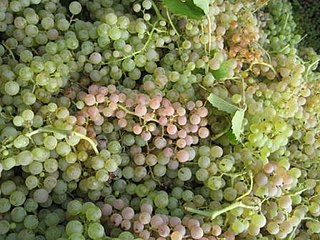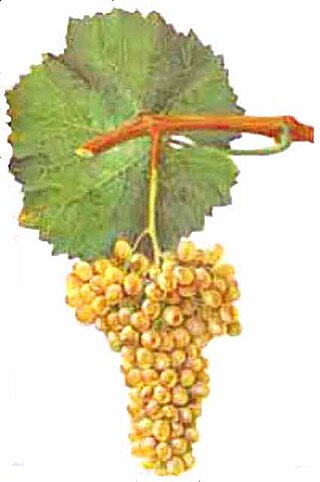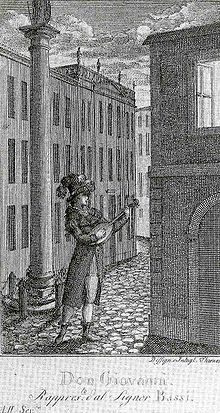
Merlot is a dark blue–colored wine grape variety that is used as both a blending grape and for varietal wines. The name Merlot is thought to be a diminutive of merle, the French name for the blackbird, probably a reference to the color of the grape. Its softness and "fleshiness," combined with its earlier ripening, make Merlot a popular grape for blending with the sterner, later-ripening Cabernet Sauvignon, which tends to be higher in tannin.

Garganega is a variety of white Italian wine grape widely grown in the Veneto region of North East Italy, particularly in the provinces of Verona and Vicenza. It is Italy's 6th most widely planted white grape. It forms the basis of Venetian white wine Soave and is also a major portion of the blend used to make Gambellara.

Lambrusco is the name of both an Italian red wine grape and a wine made principally from said grape. The grapes and the wine originate from four zones in Emilia-Romagna and one in Lombardy―principally around the central provinces of Modena, Parma, Reggio-Emilia, and Mantua. The grape has a long winemaking history, with archaeological evidence indicating that the Etruscans cultivated the vine. In Roman times Lambrusco was highly valued for its productivity and high yields, with Cato the Elder stating that produce of two-thirds of an acre could make enough wine to fill 300 amphoras.

Verdelho is a white wine grape grown throughout Portugal, though most associated with the island of Madeira, and also gives its name to one of the four main types of Madeira wine. At the turn of the 20th century it was the most widely planted white grape in Madeira.

Sauvignonasse is a white wine grape of the species Vitis vinifera prevalent in the Italian region of Friuli, and adjacent territories of Slovenia. It is widely planted in Chile, where it was historically mistaken for Sauvignon blanc.
Venetian wine is produced in Veneto, a highly productive wine region in northeastern Italy.

Lombardy wine is the Italian wine produced in the Lombardy region of north central Italy. The region is known particularly for its sparkling wines made in the Franciacorta and Oltrepò Pavese areas. Lombardy also produces still red, white and rosé wines made from a variety of local and international grapes, including Nebbiolo wines in the Valtellina region and Trebbiano di Lugana white wines produced with the Chiaretto style rosé along the shores of Lake Garda. The wine region currently has 22 denominazione di origine controllata (DOC), 5 denominazione di origine controllata e garantita (DOCG) and at least 13 indicazione geografica tipica (IGT) designations. The main cities of the region are Milan, Bergamo and Brescia. The region annually produces around 1.3 million hectolitres of wine, more than the regions of Friuli-Venezia Giulia, Marche, Trentino-Alto Adige/Südtirol and Umbria.

Friuli-Venezia Giulia wine is wine made in the northeastern Italian region of Friuli-Venezia Giulia. There are 11 denominazione di origine controllata (DOC) and 3 denominazione di origine controllata e garantita (DOCG) in the Friuli-Venezia Giulia area. The region has 3 indicazione geografica tipica (IGT) designations Alto Livenza, delle Venezie and Venezia Giulia. Nearly 62% of the wine produced in the region falls under a DOC designation. The area is known predominantly for its white wines, which are considered some of the best examples of Italian wine in that style. Along with the Veneto and Trentino-Alto Adige, the Friuli-Venezia Giulia forms the Tre Venezie wine region, which ranks with Tuscany and Piedmont as Italy's world class wine regions.
Ribolla Gialla is a white wine grape grown most prominently in the Friuli Venezia Giulia region of northeast Italy. The grape is also found in Slovenia, where it is known as Rebula. In Friuli Venezia Giulia, the grape thrives in the region around Corno di Rosazzo and Gorizia. In Slovenia, the grape is grown prominently in the Brda region. The grape is not related to the Friuli red wine grape Schioppettino, which is also known as Ribolla Nera. The obscure, lower quality Ribolla Verde grape is a mutated version that is not widely used.
Verduzzo is a white Italian wine grape grown predominantly in the Friuli-Venezia Giulia region of northeast Italy. It is also found in significant plantings in the Piave Denominazione di origine controllata (DOC) of the Veneto region, though some of these plantings may be of the separate Verduzzo Trevigiano variety. Verduzzo Friulano is used in varietal and blended wines, many of which fall under DOC as well as vino da tavola designations, that range in style from dry to late harvest wines. According to wine expert Oz Clarke, most of the sweeter examples of Verduzzo can be found in the Friuli-Venezia Giulia with the grape being used for progressively drier styles of the wine the further west into the Veneto.
Refosco dal Peduncolo Rosso is a red Italian wine grape grown predominantly in the Friuli Venezia Giulia region of northeast Italy. The grape is a variety in the Refosco family and derives its name from its red stems. It is found in the Denominazione di origine controllata (DOC) of Colli Orientali del Friuli, Friuli Aquileia, Friuli Grave and Friuli Latisana. It is also found in the Veneto portion of the Lison Pramaggiore and in the Slovenian wine region of Koper. In Slovenia, Refosco dal Peduncolo Rosso and Refosco are both called Terrano and are commonly used in a field blend.

Moscato Giallo or Yellow Muscat is a white Italian wine grape variety that is a member of the Muscat family of grapes. Known for its large deep cluster of loose, deep-yellow berries and golden colored wine, Moscato Giallo is grown mostly in northern Italy where it is most often used to produce passito style dessert wines. The grape is also planted in Croatia where it is known as Muškat žuti.

Incrocio Manzoni or Manzoni grapes is a family of grape varieties named after Professor Luigi Manzoni (1888-1968) of Italy's oldest school of oenology located in Conegliano, in the Veneto region. Manzoni created the new grape varieties by selecting, crossing and grafting vines from various vineyards during the 1920s and 1930s. The family includes both white and red grape varieties. Although most Manzonis are grown in northeastern Italy, they are mainly grown in the Piave area of Province of Treviso and are only now starting to be sold commercially in Europe and the United States.
Verduzzo Trevigiano is a white Venetian grape variety that is grown in the Eastern Veneto wine area. In the past the name Verduz referred to a wide range of grape varieties in the Venetian area. By the descriptions found, they were often morphologically very different, but shared the character of late ripening. However we can very frequently find the name Verduzzo in the ampelographic list of the 19th century, there is not any sign of this Verduzzo until the beginning of the 20th century. At that time just two varieties, with the same name Verduzzo, were still cultivated in the Veneto and Friuli area, they were what we today call Verduzzo Friulano and Verduzzo Trevigiano. The two varieties are clearly different, as demonstrated even with DNA profiling analyses in 2010 and 2011. However at the beginning of the 20th century, the two Verduzzo were called with the same name and often were present in the same vineyard and made wine together. Cosmo proposed to call the two varieties with different names: Verduzzo friulano for the varieties typical of Ramandolo production that was the only one present in that area of Friuli, and Verduzzo Trevigiano for the other one, that was present in the oriental zone of Veneto, where even Verduzzo friulano was spread, but which has a sure origin in the Treviso province how showed by the papers of Lepido Rocco.

Nosiola is a white Italian wine grape variety that is grown in the Trentino region north of Lake Garda in the Valle dei Laghi. Here it is used in varietal Denominazione di origine controllata (DOC) wines and as a blending component in wines such as Sorni Bianco from Trento. It is also used to produce a dessert wine in the Vin Santo style from grapes that have been allowed to dry out prior to fermentation.
Rossola nera is a red Italian wine grape variety that has been growing in the Valtellina region of Lombardy since at least the 17th century. In 2004 DNA profiling determined that the grape has a parent-offspring relationship with the Piedmont wine grape Nebbiolo though which variety is the parent and which is the offspring is not yet clear. However, most ampelographers believe that Nebbiolo is likely the parent variety since written records in Piedmont have noted Nebbiolo being grown since at least the 13th century.
Rossignola is a red Italian wine grape variety that is grown in the Veneto wine region of northeast Italy. The variety was first mentioned growing in the province of Verona in the early 19th century and today is a permitted blending variety in several Denominazione di origine controllata (DOC) wines of the Veneto including Bardolino and Valpolicella.
Piccola nera is a red Italian and Slovenian wine grape variety that is grown in the province of Trieste within the Friuli-Venezia Giulia wine region and across the border in neighboring Slovenia where ampelographers believe that the grape originated. Piccola nera, whose name means "little black", tends to produce to light bodied red and rosé wines that are meant to be consumed young. It is a permitted variety in the Denominazione di origine controllata (DOC) wines of Carso where it is usually blended with Terrano and in Venezia Indicazione geografica tipica IGT classification where the grape can be used to make varietal wines.
Trevisana nera is a red Italian wine grape variety that is grown in the Veneto region of northeast Italy. While ampelographers believe that the name Trevisana suggest that the grape originated in the province of Treviso, today the grape is almost exclusively found in the northern province of Belluno, particularly around the comune of Feltre, where the grape is a permitted variety in the Indicazione geografica tipica (IGT) zone of Vigneti delle Dolomiti.
Bianchetta Trevigiana is a white Italian wine grape variety that is grown in the Trentino-Alto Adige/Südtirol and Veneto wine regions of northeast Italy. Here the grape is rarely used a varietal but, instead, is a permitted blending grape adding acidity to the wines of several Denominazione di Origine Controllata (DOC) zones including the sparkling wine Prosecco and has also been used for vermouth production. The name Trevigiana is derived from the province of Treviso where the grape is believed to have originated from.












